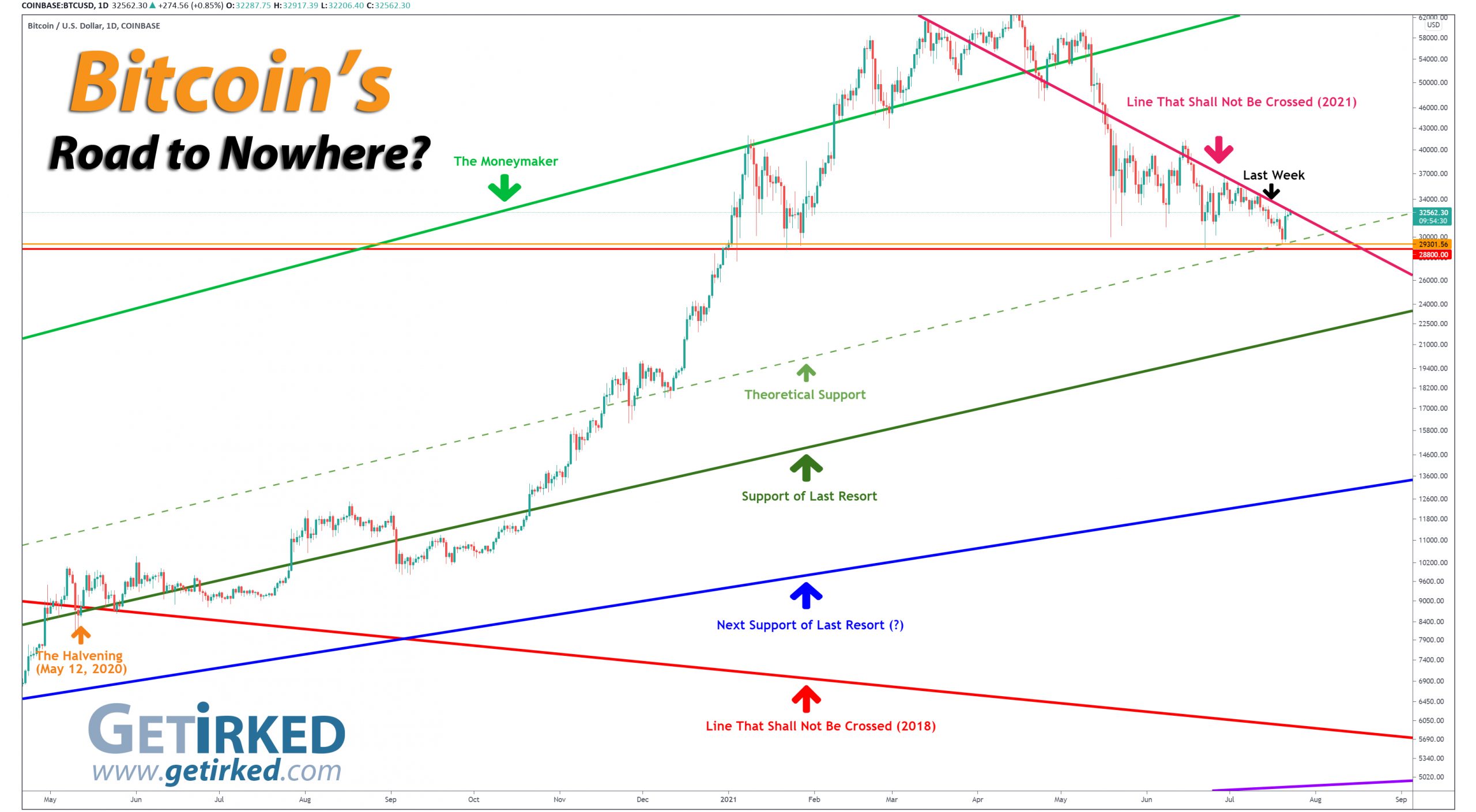Summing Up The Week
The rise of the delta variant of COVID resulted in a particularly nervous market this week. While the indexes did regain their losses, the unstable nature of the selling pressure may be showing an undercurrent of a market ready to roll over and head bearish if we have any particularly negative news events or trends.
Let’s look at the news that moved the markets this week…
Market News
COVID trends in U.S. causes market selloff
The markets sold off on Monday following reports from the CDC showing that the U.S. is seeing an increase in new COVID cases and deaths over the past 7 days, reported CNBC.
Any increase in COVID activity in the U.S. and abroad could significantly slow, delay, or even prevent a global economic reopening. “You have two concerns coming together this morning: concerns about market technicals and concerns about growth,” said Mohamed El-Erian, Chief Economic Adviser of Allianz and Perpetual Bear of All Things Investment, in an interview on CNBC. “That’s what all the asset classes are telling you this morning.”
Homebuilders pull back as pricing skyrockets
On Tuesday, data showed building permits, an indicator of future construction, fell more than expected to the lowest levels since August, reported CNBC. While this seems like a counter-intuitive result given how the cost of new homes has been skyrocketing, however, mortgage applications to purchase newly-built homes dropped nearly 24% in June year-over-year as homebuyers are priced out of the market.
“The single family market, in particular, desperately needs more homes, especially on the lower end where first-time homebuyers need some price relief and more supply choices,” said Peter Boockvar, chief investment officer at Bleakley Advisory Group. “But, we also know that it is getting more and more difficult to delivery from a builder perspective at the wanted price points.”
U.S. jobless claims show surprise gain, above estimates
On Thursday, the Labor Department reported 419,000 new weekly jobless claims versus the 350,000 expected, reported CNBC. The number was the highest weekly count since May 15, despite expectations that the job market would be improving now, not seeing signs of weakness.
Economists did point to the declining number of continuing claims, which dropped 126,000 to 3.24 million, as a potentially positive sign, however.
Next Week’s Gameplan
Summer’s low volumes continue to present a lot of volatility as well as potential buying (and selling) opportunities. As always, patience is key – if the market doesn’t provide me with any opportunities, then I just sit on my hands and watch the world go by.
This Week in Play
Stay tuned for this week’s episodes of my two portfolios Investments in Play and Speculation in Play coming online later this weekend!
Crytpo Corner
Important Disclaimer
Get Irked contributors are not professional advisers. Discussions of positions should not be taken as recommendations to buy or sell. All investments carry risk and all readers must accept their own risks. Get Irked recommends anyone interested in investing or trading any asset class consult with a professional investment adviser to determine if an investment idea is suitable to them and their investment goals.
Click chart for enlarged version
Bitcoin Price (in USD)
%
Weekly Change
Bitcoin Price Action
Here comes $30K again…
Bitcoin once again broke below $30,000, finding support at $29,301.56 late Tuesday before bouncing on Wednesday where it now tests The Line That Shall Not Be Crossed (2021). If Bitcoin can not break through and turn the trendline into support from resistance, it will remain in the overall bearish downward macro pattern.
The Bullish Case
Bulls point to the continued buying at the key $30K mark as bullish for Bitcoin’s long-term trajectory, suggesting that Bitcoin will maintain its current levels as it consolidates before heading higher.
The Bearish Case
Bitcoin has a lot to prove to the bears before they’ll change their tune. Historically, once Bitcoin tests a point of support or resistance three times, it breaks through the next time. In this case, Bitcoin has now solidly tested the $30K support line three times which could indicate the next “test” will actually a bearish break to lower levels.
The ongoing sequence of testing the lows and finding lower highs is nothing but bearish for the short- to mid-term outlook of Bitcoin and the entire crypto space. I continue to believe we’ll see a test of levels far below the $30,000 mark.
Bitcoin Gameplan
Passed on the opportunity to add below $30K…
Current Allocation: 8.034% (Unchanged from last update)
Current Per-Coin Price: $32,917.53 (Unchanged from last update)
Current Profit/Loss Status: -1.079% (+2.155% from last update)
Bitcoin ended up not pulling back as far as I believed it would during its last selloff below $30,000, leading to me not adding to my position over the past week. Given my bearish outlook on the crypto sector, I do have selling targets to reduce my allocation should Bitcoin hit my per-coin cost (as well as additional sell targets to take profits should it rise above my per-coin cost).
Bitcoin Buying Targets
Using Moving Averages and supporting trend-lines as guides, here is my plan for my next ten (10) buying quantities and prices:
0.124% @ $29,568
0.279% @ $28,958
2.793% @ $26,168
5.585% @ $23,468
5.585% @ $19,561
5.585% @ $16,147
5.585% @ $13,837
5.585% @ $11,818
5.585% @ $8,729
12.015% @ $5,977
No price target is unrealistic in the cryptocurrency space – Bullish or Bearish.
While traditional stock market investors and traders may think the price targets in the cryptocurrency space are outlandish due to the incredible spread (sometimes a drop of near -90% or a gain of up to +1000% or more), Bitcoin has demonstrated that, more than any speculative asset, its price is capable of doing anything.
Here are some of Bitcoin’s price movements over the past couple of years:
- In 2017, Bitcoin rose +2,707% from its January low of $734.64 to make an all-time high of $19,891.99 in December.
- Then, Bitcoin crashed nearly -85% from its high to a December 2018 low of $3128.89.
In the first half of 2019, Bitcoin rallied +343% to $13,868.44. - From June 2019, Bitcoin crashed -54% to a low of $6430.00 in December 2019.
- From December 2019’s low, Bitcoin rallied +64% to $10,522.51 in February 2020.
- In March 2020, Bitcoin crashed nearly -63% to a low of $3858.00, mostly in 24 hours.
- Then, Bitcoin rallied +988% to a new all-time high of $41,986.37 in January 2021.
- Later in January, Bitcoin dropped -32% to a low of $28,732.00.
- In February 2021, Bitcoin rallied +103% to a new all-time high of $58,367.00.
- Later in February, Bitcoin dropped -26% to a low of $43,016.00.
- In March 2021, Bitcoin rallied +44% to a new all-time high of $61,788.45.
- Later in March, Bitcoin dropped -19% to a low of $50,305.00.
- In April 2021, Bitcoin rallied +29% to a new all-time high of $64,896.75.
- In June, Bitcoin crashed -56% to a low of $28,800.00.
Where will Bitcoin go from here? Truly, anything is possible…
What if Bitcoin’s headed to zero?
The only reason I speculate in the cryptocurrency space is I truly believe Bitcoin isn’t headed to zero.
I am prepared for that possibility, however, by knowing I could potentially lose all of the capital I’ve allocated to this speculative investment. Professional advisers recommend speculating with no more than 5% of an investor’s overall assets. Personally, I’ve allocated less than that to speculating in crypto.
I feel that anyone who doesn’t fully believe in the long-term viability of cryptocurrency would be better served not speculating in the space.
On a good day, this asset class isn’t suitable for those with weak stomachs. On volatile days, the sector can induce nausea in the most iron-willed speculator. If a speculator isn’t confident in the space, the moves will cause mistakes to be made.
DISCLAIMER: Anyone considering speculating in the crypto sector should only do so with funds they are prepared to lose completely. All interested individuals should consult a professional financial adviser to see if speculation is right for them. No Get Irked contributor is a financial professional of any kind.
Ways to give back to GetIrked:
Send me a tip via Stripe! Thank you!
Get free money by signing up for an account with my referral link for Schwab
Sign up for Gemini and we each get $10
Click this referral link to get the Brave Browser
If you use Brave, you can also use the Tip function to tip me in Basic Attention Token (BAT).
Suicide Hotline – You Are Not Alone
Studies show that economic recessions cause an increase in suicide, especially when combined with thoughts of loneliness and anxiety.
If you or someone you know are having thoughts of suicide or self-harm, please contact the National Suicide Prevention Lifeline by visiting www.suicidepreventionlifeline.org or calling 1-800-273-TALK.
The hotline is open 24 hours a day, 7 days a week.


